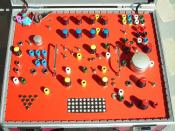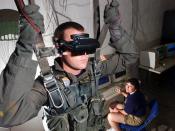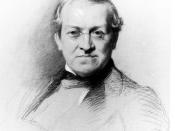Imagine being able to point into the sky and fly. Or perhaps walk through space and connect molecules together. These are some of the dreams that have come with the invention of virtual reality. With the introduction of computers, numerous applications have been enhanced or created. The newest technology that is being tapped is that of artificial reality, or "virtual reality" (VR). When Morton Heilig first got a patent for his "Sensorama Simulator" in 1962, he had no idea that 30 years later people would still be trying to simulate reality and that they would be doing it so effectively. Jaron Lanier first coined the phrase "virtual reality" around 1989, and it has stuck ever since. Unfortunately, this catchy name has caused people to dream up incredible uses for this technology including using it as a sort of drug. This became evident when, among other people, Timothy Leary became interested in VR. This has also worried some of the researchers who are trying to create very real applications for medical, space, physical, chemical, and entertainment uses among other things. In order to create this alternate reality, however, you need to find ways to create the illusion of reality with a piece of machinery known as the computer. This is done with several computer-user interfaces used to simulate the senses. Among these, are stereoscopic glasses to make the simulated world look real, a 3D auditory display to give depth to sound, sensor lined gloves to simulate tactile feedback, and head-trackers to follow the orientation of the head. Since the technology is fairly young, these interfaces have not been perfected, making for a somewhat cartoonish simulated reality. Stereoscopic vision is probably the most important feature of VR because in real life, people rely mainly on vision to get places...
Reviews of: "Virtual Reality : How it works!"
:
More Computer Science
essays:
Computer crime
... of the employees in a company on the network. The program monitors memory and file usage. A qualified system administrator should be able to tell by the amounts of memory being used and the file usage if something is going on that ...
CMIP vs. SNMP - Network Management Protocols
... we've seen with other products, once a technology achieves critical mass, and a substantial installed ... system resources that are needed for SNMP. In other words, very few systems in the world would able ... choice. It works very simply (as the name suggests): it exchanges network packets through messages ( ...
Netscape Plug-Ins
... able to display a message, or to even take user's to another page with just a simple click of the mouse. Creating Web pages is made faster with the help of QuickSilver. Current Web technology ... games, geographical information systems, chat environments, authoring ... plug-In with the same name as ...
Is your information safe?
... system. Login passwords should be changed frequently (write it down so you don't forget, but store it in a secure place), and they should never contain words or names ... technologically ...
Questions of Ethics in Computer Systems and their Future
... system, but for the vast majority this is not the means by which they invest, and with that they should not be penalized by overzealous government regulators and an industry looking to extract dollars out of a technology. You will never be able ... or under assumed names,' said Mary Schapiro , ...



I got lost
somewhere in the sound section. A whole chunk of info but poorly structured.
0 out of 0 people found this comment useful.